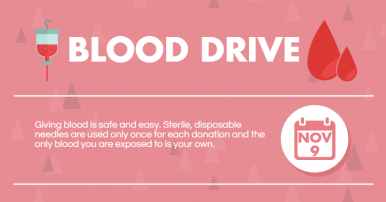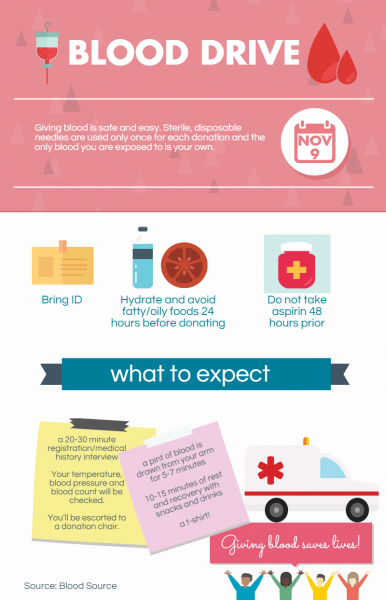Bleed for a good cause
By Annabelle Zhou,
Bluedevilhub.com Editor–
The first of the Red Cross Club’s biannual blood drives will take place in the South Gym on Monday, Nov. 9, from 7 a.m. to 3:30 p.m.
For the past month, Red Cross Club has been working hard to ensure a smooth and successful run for the blood drive.
The club works with school nurse Rhonda Youtsey and the organization BloodSource, which conducts the blood drive. Preparation kicked off with a visit from BloodSource representative Felicia Roper to a lunchtime Red Cross Club meeting in October. Roper presented samples of t-shirts, pre-printed flyers, sign-up procedures and donation statistics to excite the club about the upcoming event.
Since 1989, Davis High has hosted 42 blood drives, registered 4,779 participants and collected 3,866 pints of lifesaving blood. Red Cross Club and BloodSource “work together on the scheduling the dates as far as a year in advance and set a goal for each blood drive based on a variety of factors,” according to Roper.
140 pints of blood is the most DHS has ever collected from one blood drive. For the past six years, the amount of blood has remained around 75-85 pints.
Donated blood goes to local hospitals to be used within 40 days. Blood can also be designated to specific patients.
“One of the students asked if she could donate in the name of a friend […] who, maybe, has leukemia that would need blood and she wanted her blood to go to her friend,” Youtsey said.
Not everyone is able to donate blood, due to stringent requirements on the effects of blood loss. In order to donate blood, the student must be at least 16 years old, obtain parental consent if under 18, weigh 110 pounds, cannot be sick and cannot have recently traveled to a third-world country. Students can be turned away for low iron or other deficiencies found in their health history.
“If I could, I would definitely give blood. I would love to know I’m making a difference in someone’s life,” senior Sarah Sherwin said. “I haven’t been able to at my time here at DHS because of my fall and spring sports. Also, this past summer I went to Nicaragua.”
Sherwin’s cross-country coach Bill Gregg routinely advises athletes against donating blood. The loss of blood makes exercise harder by depleting the amount of circulating oxygen and iron which provides energy to run.
“With [the section championship meet] coming up next Saturday, it wouldn’t be smart to give blood the week of,” Sherwin said.
The effects of blood loss can last for weeks but can also be felt immediately.
“[Fainting] usually happens every year,” Youtsey said. To replenish the energy lost from giving blood, snacks and drinks are provided after.
If the student is dizzy or lightheaded, they may be kept for half an hour. “If they’re having any trouble at all, they’ll keep them longer,” Youtsey added.
“If you think about all the positive influence that you can have on the people’s lives to whom you’re giving the blood, it kind of outweighs all the negatives that could happen,” Red Cross Club secretary Andrea Zheng said. “If you follow all the guidelines provided by the Red Cross Club, like hydrating and eating before, the process should be pretty easy and mostly painless.”




